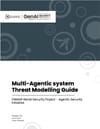What’s Covered
The MAS Threat Modelling Guide extends OWASP’s previous work on agentic threats by applying it to multi-agent systems—those involving numerous semi-autonomous agents working toward shared or distributed goals.
It’s built around the MAESTRO Framework (Multi-Agent Environment, Security, Threat, Risk, and Outcome), a layered architecture method that breaks down MAS security risks across foundation models, data operations, agent frameworks, deployment infrastructure, observability, compliance, and agent ecosystems.
Key highlights:
- Expanded Threat Surface: MAS coordination (agent-to-agent communication, decentralized task management) introduces unique risks like emergent behavior vulnerabilities, rogue agent proliferation, memory poisoning, agent collusion, and cascading trust failures.
- Cross-Layer Threat Scenarios: Detailed modeling shows how failures in one layer (e.g., foundation model bias or RAG poisoning) can propagate across the system.
- Real-World Examples: Deep-dive threat models were conducted for an RPA Expense Reimbursement Agent, Eliza OS (open-source agent OS for blockchain environments), and Anthropic’s Model Context Protocol (MCP).
- Extended Threat Scenarios: Beyond OWASP’s original taxonomy, the guide introduces ~20 new attack vectors specifically relevant to MAS, such as cross-agent feedback loop manipulation, misconfigured inter-agent monitoring, plugin vulnerabilities, and malicious bridge attacks in blockchain-connected agents.
- Integration with MITRE ATT&CK & ATLAS: Guidance is provided for connecting MAESTRO threat models to known adversarial tactics, enabling better defensive validation and telemetry alignment.
Overall, the guide transforms theoretical risks into concrete attack patterns, creating a blueprint for designing more resilient agentic AI architectures.
💡 Why it matters?
MAS systems are moving from research into critical infrastructure, from warehouse robotics to cross-platform AI assistants.
Yet MAS introduce scaling vulnerabilities unlike anything seen in traditional software or standalone AI. A single compromised agent can cascade failure through an entire system—especially when agents are self-organizing or learning in live environments.
Threat modeling at the multi-layer, cross-agent, and cross-system level is no longer optional: it’s mandatory for resilience.
The MAS guide makes this possible by delivering structured, repeatable threat modeling practices using a layered methodology.
It also helps security architects surface emergent vulnerabilities that traditional AppSec methods would likely miss.
Without frameworks like MAESTRO, organizations risk building fragile MAS architectures blind to attack chains that unfold across autonomy, communication, and collective memory.
What’s Missing
- Risk Quantification Metrics: While the guide is rich on threats and scenarios, it doesn’t provide scoring frameworks (e.g., impact, likelihood) to prioritize risks in MAS deployments.
- Defensive Patterns Catalog: Mitigations are implied but not detailed with recommended design patterns (e.g., agent isolation architectures, communication hardening techniques, sandboxing strategies).
- Agent Lifecycle Focus: More depth could have been given to threats that emerge during agent updates, retraining, or scaling (areas where real-world vulnerabilities often surface).
- Broader Ecosystem Dependencies: Integration risks with third-party plugins, cloud agent orchestration services, and cross-chain ecosystems are touched on but not deeply mapped.
Future iterations expanding these would make MAESTRO even more actionable for MAS system designers under operational pressure.
Best For
- AI system architects designing multi-agent AI platforms.
- Security engineers responsible for LLM agentic deployments or autonomous system security.
- Governance leads shaping internal AI risk policies to align with emerging agent-centric frameworks.
- Researchers and policymakers who want concrete operational examples of agent risk beyond theory.
📚 Source Details
Title: Multi-Agentic System Threat Modelling Guide
Authors: OWASP GenAI Security Project - Agentic Security Initiative Team (Ken Huang, Akram Sheriff, John Sotiropoulos et al.)
Date: April 22, 2025
License: Creative Commons (CC BY-SA 4.0)


